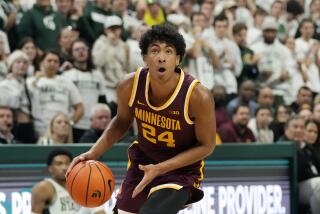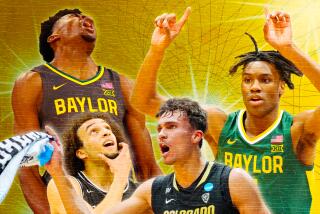YOUNGER AND THE RESTLESS : With a Record 25 Players Deciding to Try the NBA Draft Before Graduation, Will Anyone Be Left in College?
- Share via
Patience is a virtue, but when was the last time it got anybody a shoe deal?
These are the go-go-go ‘90s, when sooner is always better than later, when high school seniors pay more attention to the NBA rookie salary cap than their SATs, and when college basketball stars flicker like brief candles: shiny while they last, then quickly out, out, out. . . .
Last year, phenom Kevin Garnett paved the way from high school to the No. 5 overall selection and NBA millions in Minneapolis, but no one really knew how many would follow.
Now you know: Before last Sunday’s deadline, a record 25 players (at last count, the final total won’t be announced until this afternoon) have announced they are leaving school early for the NBA draft, including two high school seniors, the NCAA’s best two freshmen and six sophomores with star potential.
Which begs this question for college hoops:
Is there anybody left?
“I have a concern for the college game,” said former coach Pete Newell, now a scout for the Cleveland Cavaliers. “This whole process . . . now looks like it’s kind of out of control.
“I wouldn’t be surprised next year if 50 or 70 names don’t show up. Some for a lark, some because they have a slim chance, some because it’s the thing to do, some through necessity.
“Take the kid from Cal,” Newell said, referring to draft-bound freshman forward Shareef Abdur-Rahim, last season’s Pacific 10 Conference player of the year. “He’s a really good talent, but can you see him in that Knick-Chicago series playing Dennis Rodman or playing Anthony Mason or [Charles] Oakley?
“I mean, there’s roses out there that are going to bloom and be beautiful. But if you cut them before they bloom, they’ll never grow to be beautiful.”
Kobe Bryant, coming out of high school in Lower Merion, Pa., says he knows he won’t be an instant star. “I know that I’ll have to work extra hard, and I know that it’s a big step,” Bryant said.
“I can do it.”
Suddenly, it’s totally uncool to stay in school, especially with agents and assorted hangers-on clamoring for players to zoom past morning classes and demanding college coaches directly to Michael Jordan and Dream Team futures.
Already, incoming college freshmen are being measured for next year’s NBA crop. Will Arizona recruit Mike Bibby stay more than one year? Or Villanova’s Tim Thomas? Current high school juniors are muttering about coming out next June, and there’s already speculation on who will be the first prep junior to announce he’s ready for NBA play.
“There’s going to be some tragic things coming out of this, don’t kid yourself,” said Jerry West, Laker executive vice president. “They’ve all got buddies, agents running around telling them how great they are. I hope those people will be around when things are not so good.”
When the draft unfolds June 26, experts predict the first five picks could be non-seniors, perhaps nine of the first 10, including Kobe Bryant.
With the exception of potential No. 1 pick Tim Duncan from Wake Forest--who has twice forsaken the lure of being a top selection--every member of the consensus All-American team, which included one senior, will be in the NBA next season.
So will most of those who could have made up next season’s list: Georgia Tech freshman Stephon Marbury, Abdur-Rahim, Kentucky sophomore Antoine Walker and Mississippi State juniors Erick Dampier and Dontae’ Jones.
“Quite frankly, I think the college game is in serious trouble,” Kentucky Coach Rick Pitino said recently.
What returning players have proven credentials? There are Duncan, Cincinnati forward Danny Fortson, Utah forward Keith Van Horn, Kansas point guard Jacque Vaughn and . . . who?
With CBS’ college ratings taking a recent nose-dive, if schools can’t count on their best players to stay longer than a year or two, what does it do to the quality of play and interest in the game?
“I don’t see that as a problem,” Fresno State Coach Jerry Tarkanian said. “I think what you’ll see now is not one dominant team anymore, because the really great kids are going to jump to the pros in one or two years. You almost have to assume that now.
“I still think that the thing that makes the college game isn’t the players, it’s the pageantry around the game, the excitement and emotion college kids play with. I don’t think the college game is based on somebody making spectacular shots. That’s what the NBA is about.”
Said UCLA assistant Steve Lavin: “Because the couple of guys who went out straight from high school, it’s been a big story and everybody starts to think about it. But I wouldn’t imagine it’s going to be a pattern or a trend that will continue to increase. It’s kind of fun and exciting for kids to talk about it, but when it comes down to it, there won’t a dramatic change.”
Perhaps most alarming for both the NCAA and NBA is the huge number of borderline players who have declared, not the sure-fire No. 1 picks who are coming out.
Though Syracuse’s John Wallace led the Orangemen to the title game this season in his senior year and greatly improved his draft status after briefly declaring for--then opting out of--the NBA draft last year, that lesson didn’t pass on to Iowa’s Jess Settles or Washington’s Mark Sanford or Louisiana State’s Ronnie Henderson.
Last year’s advent of a rookie salary cap--a rookie can sign for no more than three years, after which he becomes a free agent--was supposed to stop the run of 13 or 14 leaving school early every year.
“I think the rookie cap actually has made it more likely for players to come out quickly,” Syracuse Coach Jim Boeheim said. “Because with the cap, nobody really makes the big, big money until after their third year--they can’t.
“So the kids are coming out because they want to get those three years over quickly, they want to get the clock started as soon as possible to make it to the big contract.”
Inflated by their own hopes, or struggling to maintain their academic eligibility, many who leave early probably will have predictably irrelevant NBA careers.
Said Marty Blake, the NBA’s scouting consultant: “I will not discuss undergraduates coming out. Do you want to know why? I’m in the middle of putting together this [pre-draft] Chicago camp, and I have no idea who’s coming.
“Let me give you an example: Jess Settles has announced he’s coming out because he’s talked to 10-12 NBA teams and knows where he’ll get drafted. That’s not allowed. A paper in Iowa called 10 teams, and they said they never talked to him.
“I’m tired of these kids coming out and saying where they’re going in the NBA draft. I have no idea, and I’ve been at this 44 years.”
Newell argues that by re-implementing the freshmen ineligibility rule, colleges could regain at least partial control of their players. If a young player is only in it for the NBA and figures he’s going to struggle in school, he can come straight out. Once he enrolls in school, he uses his first year to hit the books, then probably stays at least two more to play before departing.
But others are skeptical about the NBA being able to stop the flow.
“I don’t know how you change the rules now,” said West, who says he is unaware of any serious discussions to solve the problem. “You’re talking about legal issues, not talking about moral issues or doing the right thing.
“And you also have to know that we all have to do what’s best for our teams. If there’s some young kid out there, someone feels he is going to be real good, why shouldn’t they draft him? It’s a double-edged sword, that’s for sure.
“There’s a built-in excuse for me if they don’t play well--just a learning process, just wait a year or two. And frankly, you get tired of hearing that. Sooner or later, players have to be held accountable. . . . It’s just really frustrating.”
(BEGIN TEXT OF INFOBOX / INFOGRAPHIC)
Early Birds
In 1971, a lawsuit by Spencer Haywood enabled those who hadn’t used up their college eligibility to make themselves available for the NBA draft. In 1971 only, there was a separate hardship draft; beginning in 1976, the term “hardship” was dropped. A look at the year-by-year totals and where selected players were taken overall:
1971--6 declare.
1972--8, including Bob McAdoo of North Carolina (No. 2 pick overall).
1973--11.
1974--20.
1975--16, including Darryl Dawkins of Orlando (Fla.) Maynard Evans High (5).
1976--13.
1977--6, including Bernard King of Tennessee (7).
1978--5, including Reggie Theus of Nevada Las Vegas (9).
1979--4, including Magic Johnson of Michigan State (1).
1980--7.
1981--5, including Mark Aguirre of DePaul (1), Isiah Thomas of Indiana (2) and Buck Williams of Maryland (3).
1982--13, including James Worthy of North Carolina (1), Terry Cummings of DePaul (2) and Dominique Wilkins of Georgia (3).
1983--6, including Byron Scott of Arizona State (4), Clyde Drexler of Houston (14).
1984--9, including Akeem Olajuwon of Houston (1), Michael Jordan of North Carolina (3) and Charles Barkley of Auburn (5).
1985--12, including Wayman Tisdale of Oklahoma (2), Benoit Benjamin of Creighton (3) and Karl Malone of Louisiana Tech (13).
1986--10, including Chris Washburn of North Carolina State (3).
1987--9.
1988--12.
1989--14, including J.R. Reid of North Carolina (5) and Shawn Kemp of Trinity Valley CC, Texas, (17).
1990--14, including Chris Jackson of Louisiana State (3).
1991--12, including Kenny Anderson of Georgia Tech (2) and Billy Owens of Syracuse (3).
1992--16, including Shaquille O’Neal of Louisiana State (1) and Jimmy Jackson of Ohio State (4).
1993--12, including Chris Webber of Michigan (1), Shawn Bradley of Brigham Young (2), Anfernee Hardaway of Memphis State (3) and Jamal Mashburn of Kentucky (4).
1994--20, including Glenn Robinson of Purdue (1), Jason Kidd of California (2), Donyell Marshall of Connecticut (4) and Juwan Howard of Michigan (5).
1995--19, including Joe Smith of Maryland (1), Antonio McDyess of Alabama (2), Jerry Stackhouse of North Carolina (3), Rasheed Wallace of North Carolina (4) and Kevin Garnett from Farragut Academy in Chicago (5).
The 25 non-seniors who have made themselves eligible for the 1996 NBA draft:
JUNIORS (14)
Ray Allen, g, Connecticut
Marcus Camby, c, Massachusetts
Erick Dampier, c, Miss. St.
Ronnie Henderson, g, LSU
Dontae’ Jones, f, Miss. St.
Chris Kingsbury, f, Iowa
Jeff McInnis, g, North Carolina
Terquin Mott, f, Coppin St.
Jason Osborne, f, Louisville
Darnell Robinson, f, Arkansas
Greg Simpson, g, West Virginia
Vitaly Potapenko, c, Wright St.
Jess Settles, f, Iowa
Kebu Stewart, c, CS Bakersfield
SOPHOMORES (7)
Sunday Adebayo, f, Arkansas
Allen Iverson, g, Georgetown
Randy Livingston, g, LSU
Mark Sanford, f, Washington
Antoine Walker, f, Kentucky
Samaki Walker, c, Louisville
Lorenzen Wright, c, Memphis
FRESHMEN (2)
Shareef Abdur-Rahim, f, California
Stephon Marbury, g, Georgia Tech
HIGH SCHOOL (2)
Kobe Bryant, f, Lower Merion, Pa.
Jermaine O’Neal, f, Eau Claire, S.C.
More to Read
Go beyond the scoreboard
Get the latest on L.A.'s teams in the daily Sports Report newsletter.
You may occasionally receive promotional content from the Los Angeles Times.










